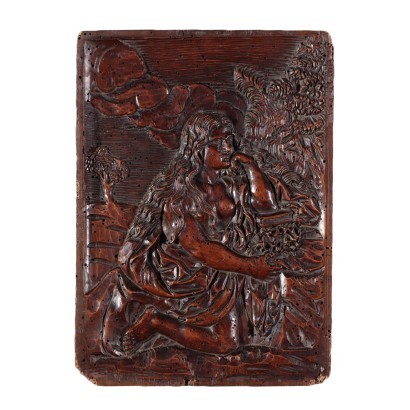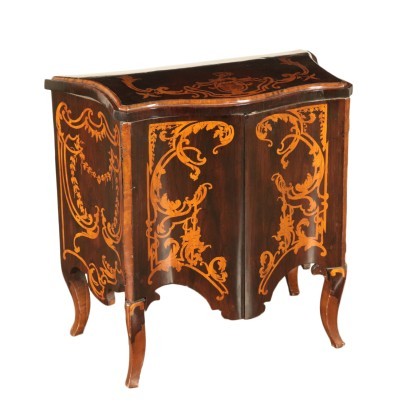“
https://anticonline.net/formella-in-legno-maddalena-penitente/
„
Penitent magdalene Tile Carved Wood
Features
Age: 17th Century / 1601 - 1700
Origin: Italy
Main essence: Linden
Description
Tile in lime-wood, on which is represented, in bas-relief, a penitent Magdalene. The saint is kneeling at the foot of a rocky crag, with the air absorbed and contrite and his eyes full of tears. The left elbow resting on a book, the hand supporting the head, while in front of her, perched on the rock, there is the crown of thorns. He is wearing a long coat that is draped plastic that wraps around the body, the thick hair falling on the shoulders and on the back. Attention has been paid to the contextualization of the landscape to the rear, through the discussion of different surfaces through the use of the burin. If the vegetation and the rocky landscape are quite natural, especially in the description of the leaves, almost as if they were blowing in the wind, the more abstraction is discernible in the depiction of the sky, made with dense parallel horizontal lines.
Product Condition:
Product in good conditions, shows some signs of wear.
Dimensions (cm):
Height: 33,5
Width: 24,3
Depth: 1
With certificate of authenticity
Certificate issued by: Enrico Sala
Additional Information
Notes historical bibliographic
Mary Magdalene is one of the figures of saints, most represented in western art, of which there are different iconographies. Before conversion it is in fact depicted as a woman richly dressed and adorned with jewelry while in the representations subsequent to the amendment is portrayed in the way of the penitent, even if often accompanied by jewellery or precious objects, but now abandoned in a corner. The santa has now converted and shuns worldly goods, and depicted dressed only in a long cloak, if not even naked, with her long hair covering her body; it is often found in front of a cave or surrounded by a desert landscape. In the attitude of the penitent, the eye is full of tears, to the memory of the gospel story concerning the washing of the feet of Jesus. It is often accompanied by various attributes: in our tile, belonging to this iconography, the crown of thorns, symbol of the Passion of Christ and a book, to indicate meditation and reflection subsequent to the conversion. Our bas-relief is a derivation from a painting by Guercino unfortunately lost, but recorded in the inventory of Farnese relating to the Palazzo del Giardino in Parma: "S. ta M. to mary Magdalene, who contemplates in the act to the point of tears and the crown of thorns above a stone, Guerzino from one Hundred...". Fortunately, the image came to us through a contemporary copy, preserved at the Museo di Capodimonte in Naples. This iconography was certainly very much appreciated, as evidenced by the many copies made in later centuries. In many branches the lower part of the figure of the saint is not visible, while in our tile appears to be entirely and also the legs and the feet are left uncovered, are visible. The engraver, who translated the painting in bas-relief was very careful also to the revival of the clouds and the landscape behind, with a small license in addition of the tree on the left. The type of carving typical of the baroque can be dated to the work of the SEVENTEENTH century.
Age: 17th Century / 1601 - 1700
17th Century / 1601 - 1700
Main essence: Linden
It is a soft, whitish and light wood, used in the past for inlay and carving works. 


















